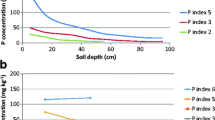Abstract
The definition, testing and uses of explanatory models in plant nutrition are discussed and contrasted with descriptive, predictive models. Two examples are given. First a model of phosphorus acquisition by rice plants growing in soils that undergo flooding and drainage, in which changes in the soil induced by roots are important. The changes are, in flooded anaerobic soil, oxidation of mobile reductants and consequent production of H+ ions in the soil as well as direct release of H+ ions from the roots to balance excess intake of cations over anions; and in non-flooded aerobic soil, release of organic anions from the roots. The model's predictions are tested against experimental data. Second a model of N acquisition by rice plants in flooded anaerobic soil, in which the uptake properties of the roots are important. The contribution to N uptake of NO3 − formed in the rhizosphere of rice in flooded soil is compared with that of NH4 + from the bulk soil using a model and absorption properties of rice roots measured in nutrient culture. The models' uses and limitations are discussed.
Similar content being viewed by others
References
Darrah P R and Roose T 2001 Modeling the rhizosphere. In The Rhizosphere: Biochemistry and Organic Substances at the Soil-Plant Interface. Eds R Pinton, Z Varanini and P Nannipieri. pp 327–372. Marcel Dekker, New York.
Ellis J R 1998 Post flood syndrome and vesicular-arbuscular mycorrhizal fungi. J. Prod. Agric. 11, 200–204.
Huguenin-Elie O, Kirk G J D and Frossard E 2002 Phosphorus uptake by rice from soil that is moist, flooded or flooded then moist. Eur. J. Soil Sci., in press.
Ilag L L, Rosales A M, Elazegui F A and Mew T W 1987 Changes in the population of infective endomycorrhizal fungi in a rice-based cropping system. Plant Soil 103, 67–73.
IRRI (International Rice Research Institute) 1998 Reversing Trends of Declining Productivity in Intensive Irrigated Rice Systems. Progress Report 1997. International Rice Research Institute, Manila.
Kirk G J D 1999 A model of phosphate solubilization by organic anion excretion from plant roots. Eur. J. Soil Sci. 50, 369–378.
Kirk G J D 2002 Modelling root-induced solubilization of nutrients. Plant Soil, in press.
Kirk G J D and Kronzucker H J 2000 Nitrogen uptake by rice roots. In Carbon and Nitrogen Dynamics in Flooded Soils. Eds G J D Kirk and D C Olk. pp. 147–162. IRRI, Manila.
Kirk G J D and Saleque M A 1995 Solubilization of phosphate by rice plants growing in reduced soil: prediction of the amount solubilized and the resultant increase in uptake. Eur. J. Soil Sci. 46, 247–255.
Kirk G J D, Santos E E and Santos M B 1999 Phosphate solubilization by organic anion excretion from rice growing in aerobic soil: rates of excretion and decomposition, effects on rhizosphere pH, and effects on phosphate solubility and uptake. New Phytol. 142, 185–200.
Kirk G J D and Solivas J L 1997 On the extent to which root properties and transport through the soil limit nitrogen uptake by lowland rice. Eur. J. Soil Sci. 48, 613–621.
Kronzucker H J, Kirk G J D, Siddiqi M Y and Glass A D M 1998a Effects of hypoxia on 13NH 4+ fluxes in rice roots: kinetics and compartmental analysis. Plant Physiol.116, 581–587.
Kronzucker H J, Schjoerring J K, Erner Y, Kirk G J D, Siddiqi M Y and Glass A D M 1998b Dynamic interactions between root NH+4 influx and long-distance N translocation in rice: insights into negative feedback processes. Plant Cell Physiol. 39, 1287–1293.
Kronzucker H J, Siddiqi M Y, Glass A D M and Kirk G J D 1999 Nitrate-ammonium synergism in rice: a subcellular flux analysis. Plant Physiol. 119, 1041–1045.
Kronzucker H J, Glass A.D M, Siddiqi M Y and Kirk G J D 2000 Comparative kinetic analysis of ammonium and nitrate acquisition by tropical lowland rice: implications for rice cultivation and yield potential. New Phytol. 145, 471–476.
Miller S P 2000 Arbuscular mycorrhizal colonization of semiaquatic grasses along a wide hydrologic gradient. New Phytol. 145, 145–155.
Nye P H 1992 Towards the quantitative control of crop production and quality. I. The role of computer models in soil and plant research. J. Plant Nutr. 15, 1121–1150.
Saleque M A and Kirk G J D 1995 Root-induced solubilization of phosphate in the rhizosphere of lowland rice. New Phytol. 129, 325–336.
Wang Y M, Siddiqi M Y, Ruth T J and Glass A D M 1993 Ammonium uptake by rice roots. II. Kinetics of 13NH 4+ influx across the plasmalemma. Plant Physiol. 103, 1259–1267.
Author information
Authors and Affiliations
Rights and permissions
About this article
Cite this article
Kirk, G.J.D. Use of modelling to understand nutrient acquisition by plants. Plant and Soil 247, 123–130 (2002). https://doi.org/10.1023/A:1021115809702
Issue Date:
DOI: https://doi.org/10.1023/A:1021115809702




